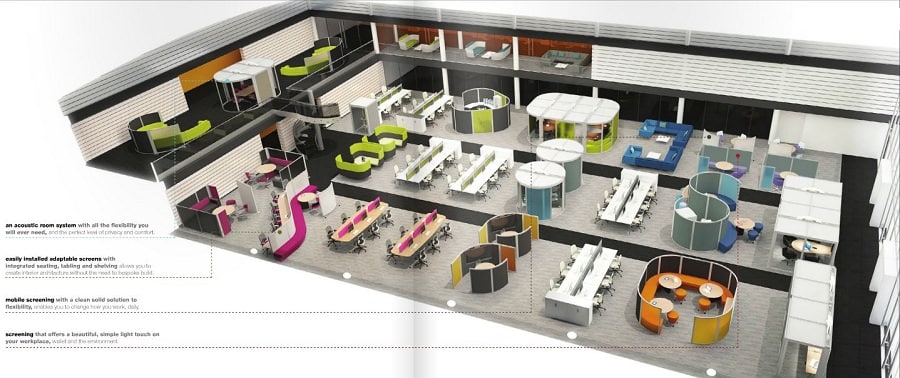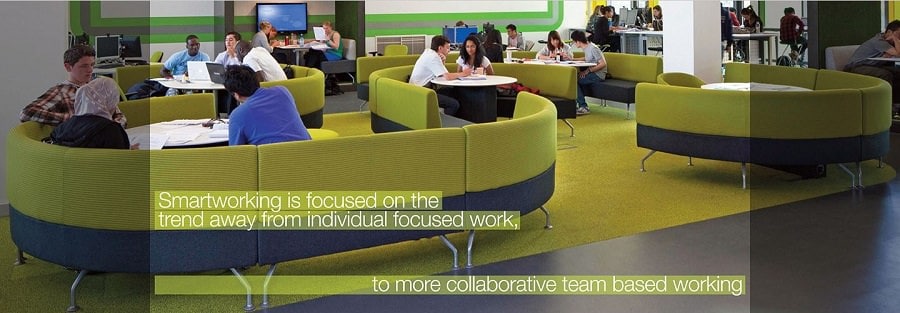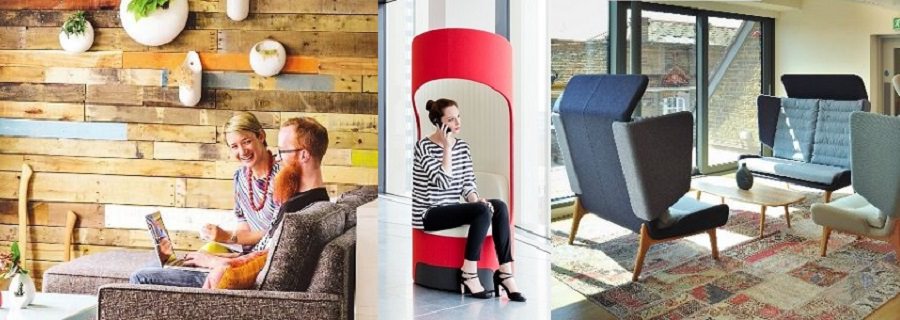
Office Design Ideas
Networked Landscape Office Design – a step on from task based office design
Task or activity based office design has been the accepted approach for several years, the precise embodiment of ‘new ways of working’. Effective office landscapes were an amalgam of differing zones – concentration, collaboration, breakout and meeting spaces interspersed with common use resources such as copy and print hubs, refreshment areas, the odd cellular office and individual privacy spots. The target of task-based design is to give appropriate space and settings for the task at hand. Desks still play a major role, as do meeting rooms, but other work modes also get a place in the design.

This design approach made use of the space vacated by a 1-man 1-desk correlation to introduce variety and inspiration but also to give back a sense of focus to regular desk work.
Gradual evolution in design thinking, and absorbing the pro’s and con’s of task based design, has moved office design on a step. The networked landscape is the new vision.
Research has shown staff perform better with a degree of control over their space. The ability to take task based design and add in a sense of control is achievable. The networked landscape integrates building systems with collaborative working. Privacy and concentration can live happily alongside breakout and team spaces.
Choice and control makes for a more satisfying workplace, adding to the possibilities for innovation that is a desirable by-product of the office environment.
So what form does the networked landscape take?

The appearance is not so different from successful task-based design. The major difference comes in the success of making spaces responsive, or with better control of acoustics, so that collaboration doesn’t undermine focus. These factors are freeing up the designers creativity, and enabling staff to benefit from new office design ideas without the limiting issues of noise, cooling, fire detection or sprinklers.
Networked landscapes are a springboard to flexibility, empowering people to fine tune the office without a 3-Act play to reconfigure. It could be said the networked landscape is moving office design further towards a responsive ideal, making offices more relevant and reducing barriers to change.
New Office Design – the principle differences
The point of difference between task based design and a networked landscape lies in two evolutions.
- Greater choice and control for staff.
- Less inertia from architecture and facilities.
Offices are increasingly about connecting people rather than connecting things (furniture, hardware, services). Urban areas are expected to have vitality and amenity. So to should offices.
An advantage of networked landscape design is greater adaptation to the wide range of generations and their workstyles. Much has been said about millennials having radically different expectations of an office environment. Balancing the needs of staff is an inherent feature of the new office design approach.

Latterly a downside of technology is the ‘always on, always visible’ scenario which can be at odds with our human need to refresh and take a break. Better office design fosters individuality as a counterpoint, giving space and time when our lives can be over-connected. The networked landscape reflects this parallel.
Contemporary workplaces now have less corporate and more individual. This doesn’t mean conflict between practical and personal, but does more than ever mean design vision is needed to yield results.
The new design thinking needs a spotlight on space utilisation. Having broken free from desk utilisation rates of 70%, 60% or even 50%, we shouldn’t jump into the fire by adding lots of poorly used non-corporate spaces. Facilities teams should track and record traffic and usage and re-purpose an area that isn’t earning its keep. Fortunately this adaptability is a basic part of the new office design. When cost of change is low it’s easy to make areas reach a standard…or get out of town.
 Delivering a Networked Landscape
Delivering a Networked Landscape
Your organisation has broken the 1-desk 1-person link. Breakout spaces, quiet booths, soft meeting areas and collaboration zones are in use in the building. What next?
Designing a networked landscape requires several add-ons.
- Furniture should be more flexible in layout, more eclectic in appearance.
- Reduce conformity, add diversity and choice.
- Enclosed pods should integrate with building systems.
- Acoustics can be tuned and controlled.
- Log usage of spaces and review the low frequented areas.

The basic office design principles you’re aiming at are –
- Work is becoming more collaborative.
- Office work has multiple modes and needs multiple spaces.
- Technology no longer sits on the desk.
- Staff value good workspaces.
- Flexibility and agility are beneficial for staff and organisations alike.
See our Office Design page for information on our design services, or call our team here at Fusion Office Design for more information.